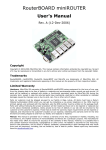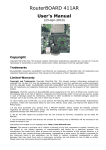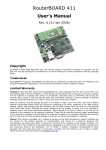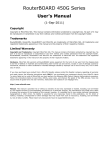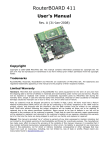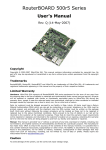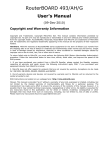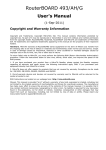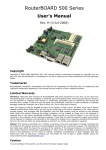Download MikroTik RouterBoard 1200 User`s manual
Transcript
RouterBOARD Crossroads User's Manual Rev. A (11-Jun-2007) Copyright Copyright © 2003-2007 MikroTikls SIA. This manual contains information protected by copyright law. No part of it may be reproduced or transmitted in any form without prior written permission from the copyright holder. Trademarks RouterBOARD, RouterOS, RouterBOOT and MikroTik are trademarks of MikroTikls SIA. All trademarks and registered trademarks appearing in this manual are the property of their respective holders. Limited Warranty Hardware. MikroTikls SIA warrants all RouterBOARD Crossroads series equipment for the term of one year from the shipping date to be free of defects in materials and workmanship under normal use and service. All parts will be repaired or replaced with similar or functionally equivalent parts by MikroTikls SIA during the warranty term, except in case the returned parts have mechanical, electrical or other accidental or intended damages caused by improper use or due to wind, rain, fire or other acts of nature. Parts (or systems) must be shipped pre-paid to our facility in Riga, Latvia. All items must have a Return Material Authorization (RMA) which you can get by contacting us via email, telephone or fax. RMA must be printed, signed, and enclosed with the shipment, also the RMA number must be written on the package itself. Parts sent without following the proper procedure will be treated as those not to be repaired or replaced due to the above mentioned conditions. Items proved to be free of defects in our lab will be returned to the customer at the customer's expense. Those that do meet the warranty repair requirements will be repaired or replaced, and returned to the customer's location at our expense, extending the warranty term for the time the items are being shipped to and from our facility and replaced or repaired. Manual. This manual is provided “as is” without a warranty of any kind, expressed or implied, including, but not limited to, the implied warranty of merchantability and fitness for a particular purpose. The manufacturer has made every effort to ensure the accuracy of the contents of this manual, however, it is possible that it may contain technical inaccuracies, typographical or other errors. No liability is assumed for any inaccuracy found in this publication, nor for direct or indirect, incidental, consequential or other damages that may result from such an inaccuracy, including, but not limited to, loss of data or profits. Please report any inaccuracies found to [email protected]. RouterBOARD Crossroads User's Manual Table of Contents Copyright.......................................................................................................................................1 Trademarks....................................................................................................................................1 Limited Warranty............................................................................................................................1 System Board View.........................................................................................................................3 System Board Layout.......................................................................................................................3 Block Diagram................................................................................................................................3 Specifications.................................................................................................................................4 Hardware Guide..............................................................................................................................5 Memory and Storage Devices...................................................................................................5 Onboard Memory...........................................................................................................5 Onboard NAND Storage Device........................................................................................5 Input/Output Ports..................................................................................................................5 LAN Port with PoE..........................................................................................................5 WLAN Interface.............................................................................................................5 DB9 Serial Port..............................................................................................................5 LEDs.....................................................................................................................................5 Power LED....................................................................................................................5 Wireless LEDs................................................................................................................5 User's Guide...................................................................................................................................5 Assembling the Hardware........................................................................................................5 Powering...............................................................................................................................6 Booting options......................................................................................................................6 Onboard NAND Storage Device........................................................................................6 Booting from network.....................................................................................................6 Operating System Support.......................................................................................................6 System Architecture.......................................................................................................6 MikroTik RouterOS.........................................................................................................7 RouterBOOT...................................................................................................................................7 Boot Loader Configuration........................................................................................................7 Configurable Options......................................................................................................7 Boot Loader Upgrading............................................................................................................8 Appendix.......................................................................................................................................9 Connector Index.....................................................................................................................9 Jumper Index.......................................................................................................................10 Button Index........................................................................................................................10 Ethernet Cables....................................................................................................................10 Serial Null-modem (Console) Cable with Loopback.....................................................................10 2 RouterBOARD Crossroads User's Manual System Board View System Board Layout Block Diagram 11..60V DC power jack Power Supply 12/48V PoE 100BaseTX (with PoE in) Onboard RAM CPU Onboard Flash (NAND) Serial port WLAN LEDs GPIO WLAN Antenna Connectors 3 RouterBOARD Crossroads User's Manual Specifications RouterBOARD Crossroads CPU Memory Boot loader Data storage Ethernet MIPS32 4KEc based 184MHz embedded processor 32MB SDRAM onboard memory chip RouterBOOT, 1Mbit Flash chip 128MB onboard NAND memory chip One 10/100 Mbit/s Fast Ethernet port supporting Auto-MDI/X Wireless standards IEEE802.11b (1..11Mbit/s, auto-fallback); IEEE802.11g (6..54Mbit/s, auto-fallback, IEEE802.11b compatibility option) Wireless frequency 2412..2472MHz (5MHz step) and 2484MHz channels; 22MHz bandwidth B or B/G mode; 20MHz (standard), 40MHz (turbo), 5 and 10MHz (reduced) bandwidth in G mode Output power Receive sensitivity Serial port LEDs Speaker One DB9 RS232C asynchronous serial port Power, a LED pair for wireless interface Mini PC-Speaker Power options IEEE802.3af Power over Ethernet: 12V or 48V DC (Including power over datalines) Power jack: 11..60V DC Power output 3V and 5V DC fan power output headers, maximal output current - 500mA total Dimensions 10.5 cm x 9.5 cm (4.13 in x 3.74 in) Weight Temperature Humidity Power consumption 4 Operational: -20°C to +70°C (-4°F to 158°F) Operational: up to 70% relative humidity (non-condensing) typical – 6W, max - 12W RouterBOARD Crossroads User's Manual Hardware Guide Memory and Storage Devices Onboard Memory The boards are equipped with one 32MB SDRAM memory chip. Onboard NAND Storage Device The boards are equipped with one 128MB NAND nonvolatile memory chip. Input/Output Ports LAN Port with PoE This Fast Ethernet port is compatible with IEEE802.3af Power over Ethernet standard and PoE active (802.3af The board accepts non-standard voltage input in wide range: from 11 to 60 V DC. The RouterBOARD 51 power injector may be used to power the board with up to 100m (330 ft) long Ethernet cable. It is suggested to use 48V DC power for power over long cables because of better efficiency (less power is lost in the cable itself and power supply is more efficient on higher voltage). When using a PoE switch to power the Crossroads – there can be a small timeout before power is delivered and the board starts, wait a few seconds. See Connector Index for pinout of the standard cable required for PoE. All cables made to EIA/TIA 568A/B cable specifications will work correctly with PoE. Note that this port supports automatic cross/straight cable correction (Auto MDI/X), so you can use either straight or cross-over cable for connecting to other network devices. WLAN Interface This onboard IEEE802.11b/g wireless interface provides stable radio connection on the standard 2.4GHz frequency range with 400mW maximum output power (FCC). It has two antenna connectors, of which only the main one (J5) is used by default, but the auxiliary connector (J4) can be configured in the software as well. DB9 Serial Port The RS232C standard male DB9 asynchronous serial port may attaching a modem or any other RS232 serial device. TxD (pin 3) DCD and DSR signals are not connected. This implementation hardware flow-control so software flow-control (XON/XOFF) should be used for initial configuration, or for of this port has -5V DC power when idle. may not be considered to support full be used. LEDs Power LED A Blue LED is lit when the board is powered. Wireless LEDs A pairs of LEDs are connected to the onboard wireless interface according to standards. User's Guide Assembling the Hardware First use of the board: ● In most cases you do not need to configure jumpers. JP2 PoE control is disabled by default, you may want to enable it to comply with IEEE802.3af requirements. See Jumper Index for details. ● Install the board in a case. 5 RouterBOARD Crossroads User's Manual ● Connect other peripherals and cables You can also order a pre-assembled system with RouterBOARD already installed in a case. Powering Power options: ● J7 power jack: 11..60V DC (JP2 should be closed) ● IEEE802.3af Power over Ethernet (PoE) on the Ethernet port: 48V DC (JP2 PoE control should be open to comply with standard requirements) 12V DC non-standard PoE powering support (JP2 PoE control should be closed) RouterBOARD Crossroads is equipped with a reliable 10W onboard power supply that accepts a wide range of input voltages. The board has a direct-input power jack J7 (5.5mm outside and 2mm inside diameter, female, pin positive plug) and can as well be powered with PoE. Both power inputs are always active, but only one should be used at the same time. Crossroads series boards are compliant with IEEE802.3af Power over Ethernet standard (except power over datalines) and accept 48V powering over up to 100m (330 ft) long Ethernet cable connected to the Ethernet port (J5 or J6). The board also accepts non-standard PoE input voltage. JP2 should only be opened when high-voltage PoE is used. IEEE802.3af PoE controller is only operational starting from 22-24V DC, so when powering from lower voltage (from either PoE or power jack), make sure the controller is disabled by shorting the JP2 jumper. Booting options First, RouterBOOT loader is started. It displays some useful information on the onboard RS232C asynchronous serial port, which is set to 115200bit/s, 8 data bits, 1 stop bit, no parity by default. The loader may be configured to boot the system from the onboard NAND module or from Ethernet network. See the respective section of this manual for how to configure booting sequence and other boot loader parameters. Onboard NAND Storage Device The RouterBOARD may be started from the onboard NAND storage chip. As there is no partition table on the device, the boot loader assumes the first 4MiB form a YAFFS filesystem, and executes the file called “kernel” stored in the root directory on that partition. It is possible to partition the rest of the medium by patching the kernel source. Booting from network Network boot works similarly to PXE or EtherBoot protocol, and allows you to boot a Crossroads series computer from an executable image stored on a TFTP server. It uses BOOTP or DHCP (configurable in boot loader) protocol to get a valid IP address, and TFTP protocol to download an executable (ELF) kernel image combined with the initial RAM disk (inserted as an ELF section) to boot from (the server's IP address and the image name must be sent by the BOOTP/DHCP server). To boot the RouterBOARD computer from Ethernet network you need the following: ● An ELF kernel image for the loader to boot from (you can embed the kernel parameters and initrd image as ELF sections called kernparm and initrd respectively) ● A TFTP server which to download the image from ● A BOOTP/DHCP server (may be installed on the same machine as the TFTP server) to give an IP address, TFTP server address and boot image name See the RouterBOOT section on how to configure loader to boot from network. Note that you must connect the RouterBOARD you want to boot, and the BOOTP/DHCP and TFTP servers to the same broadcast domain (i.e., there must not be any routers between them). Operating System Support System Architecture Crossroads series embedded boards are fully compatible with the standard MIPS32 architecture with PCI bus. 6 RouterBOARD Crossroads User's Manual CPU. Crossroads series has MIPS32 little-endian based embedded processor using MIPS 4KEc CPU core. It is fully binary-compatible with all software developed for MIPS32 little-endian (mipsel) instruction set architecture. The MIPS 4KEc core includes TLB Memory Management Unit and does not include Float Point Unit (so it is optimized for integer operations). Ethernet. Crossroads has one onboard Ethernet ports controlled by Atheros AR2316 embedded Fast Ethernet controller. MikroTik RouterOS MikroTik RouterOS, starting from version 2.9.38 (RouterBOARD 100/500 edition) Crossroads series embedded boards. RouterBOOT The RouterBOOT firmware (also referred as “boot loader” here) provides minimal functionality to boot an Operating System. It supports serial console via the onboard serial port at the boot time. The loader supports booting from the onboard NAND device, CompactFlash or IBM Microdrive, and from a network server (see the respective section for details on this protocol). Supported OSs: ● MikroTik RouterOS starting with version 2.9.38 Boot Loader Configuration Loader parameters may be configured through the onboard RS232C DB9 asynchronous serial interface. To connect to it, use a standard null-modem cable. By default, the port is set to 115200bit/s, 8 data bits, 1 stop bit, no parity. Note that the device does not fully implement the hardware (RTS/CTS) flow control, so it is suggested to try to disable hardware flow control in the terminal emulation program in case the serial console does not work as expected, and if it does not help, make a new cable using the pinout given in the Appendix. To enter the loader configuration screen, press any key (or only [Delete] key (or [Backspace] key – see the note for the respective configurable option), depending on the actual configuration) just after the loader is asking for it: RouterBOOT booter 1.5 RouterBoard Crossroads CPU frequency: 184 MHz Memory size: 32 MB Press any key within 5 seconds to enter setup RouterBOOT-1.5 What do you want to configure? d - boot delay k - boot key s - serial console o - boot device u - cpu mode r - reset configuration g - upgrade firmware i - board info p - boot protocol t - do memory testing x - exit setup your choice: To select a menu point, press the key written at the beginning of this line. Pressing [Enter] selects the option marked with '*'. Configurable Options boot delay – how much time to wait for a key stroke while booting (1..9 seconds; 2 second by default). boot key – which key will cause the loader to enter configuration mode during boot delay (any key | <Delete> key only; any key by default). Note that in some serial terminal programs, it is impossible to use 7 RouterBOARD Crossroads User's Manual the [Delete] key to enter the setup – in this case it might be possible to do this with the [Backspace] key. serial console – to configure initial serial console bitrate (1200 | 2400 | 4800 | 9600 | 19200 | 38400 | 57600 | 115200; 115200 bps by default). boot device – initial boot device (boot over Ethernet | boot from NAND | boot Ethernet once, then NAND; boot from NAND by default). You can also select boot chosen device option to boot from the device selected immediately, without saving the setting. cpu mode – whether to enter CPU suspend mode on WAIT instruction (power save | regular; power save by default). Most OSs use WAIT instruction during CPU idle cycle. When CPU is in suspend mode, it consumes less power, but in low-temperature conditions (below 0°C) it is recommended to choose regular mode, so that overall system temperature would be higher. reset configuration – whether to reset all the boot loader settings to their respective default values (yes | no; no by default). upgrade firmware – receive a new boot loader image using XModem protocol over serial line or using DHCP/BOOTP and TFTP protocols through the Ethernet network (upgrade firmware over ethernet | upgrade firmware over serial port). board info – prints the serial number, boot loader version, CPU frequency, memory size and MAC addresses of the onboard Ethernet ports boot protocol – network booting protocol (bootp protocol | dhcp protocol; bootp protocol by default). do memory testing – performs a full memory test. Boot Loader Upgrading The boot loader is needed to initialize all the hardware and boot the system up. Newer loader versions might have support for more hardware, so it's generally a good idea to upgrade the loader once a newer version is available. You can upgrade the loader through the onboard serial port using XModem protocol (programs available for all major OSs). For example, you can use HyperTerminal for Windows or Minicom for Linux to upload the boot loader. Alternatively if you have a DHCP/BOOTP and TFTP servers available, you can specify the loader image as a boot image and choose the bios upgrade over ethernet option in the boot loader configuration menu. The loader will get the image from the TFTP server and upgrade itself. The most current loader image is available for download on www.routerboard.com. If you are using a Microsoft Windows series operating system, you can use the remote upgrading application available on www.routerboard.com. This program boots the RouterBOARD from network and upgrades the loader. Note that the upgrade may only take place within the same broadcast domain (i.e. there must not be any routers between the Windows-based machine and the upgradable RouterBOARD). The boot loader upgrading is supported also from MikroTik RouterOS. The procedure is described in the MikroTik RouterOS manual. 8 RouterBOARD Crossroads User's Manual Appendix Connector Index J3 RS232C male DB9 serial port 2 RxD (Receive Data) 3 TxD (Transmit Data) 4 DTR (Data Terminal Ready) 5 GND 7 RTS (Request To Send) J4 Auxillary antenna connector J5 Main antenna connector J6 RJ45 Fast Ethernet 100Base-TX port with IEEE802.3af PoE extension 1 Data TX+ 2 Data TX3 Data RX+ 4 PoE power + 5 PoE power + 6 Data RX7 PoE power 8 PoE power - J7 Power jack (11..60 V DC, positive contact is the central pin) J8 External Fast Ethernet header 1 Data TX+ 2 Data TX3 Data RX+ 4 PoE power + 5 PoE power + 6 Data RX7 PoE power 8 PoE power - J9 External serial header 3 RxD (Receive Data) 4 TxD (Transmit Data) 6 GND JP1 External speaker header JP3 5V power output JP4 3V power output 9 RouterBOARD Crossroads User's Manual Jumper Index JP2 IEEE802.3af Power over Ethernet standard operation. The controller is only stable starting from 22-24V DC power input, so when powering from lower voltages, it should be disabled. Note that the controller is active for both PoE and J7 power jack, so even when not using PoE, disable the controller for lower voltages. Open Normal operation according to IEEE802.3af Power over Ethernet standard Closed Disable PoE control (for passive PoE injectors and/or input voltage less than 22V) Button Index S1 Software reset button (GPIO6) Ethernet Cables RJ45 Pin Color Function RJ45 pin for Straight cable RJ45 pin for Crossover cable (MDI, EIA/TIA568A) (MDI-X, EIA/TIA568B) 1 Green TX+ Data 1 3 2 Green/White TX- Data 2 6 3 Orange RX+ Data 3 1 4 Blue - 4 4 5 Blue/White - 5 5 6 2 6 Orange/White RX- Data 7 Brown - 7 7 8 Brown/White - 8 8 Serial Null-modem (Console) Cable with Loopback DB9f Function DB9f DB25f 1 + 4 + 6 CD + DTR + DSR 1 + 4 + 6 6 + 8 + 20 10 2 RxD 3 2 3 TxD 2 3 5 GND 5 7 7+8 RTS + CTS 7+8 4+5










